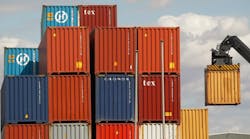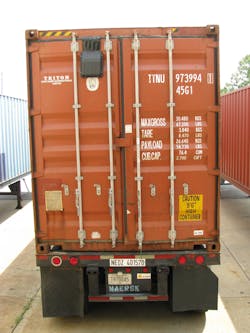As more high value items move through domestic and international supply chains, more and more cargo is lost. Where international cargo is concerned, government is also concerned. Customs and Border Protection (CBP) has the duty to know what is in a shipping container coming into or passing through the United States not only for duty assessment, but also for the security of the nation. That means CBP regulations can complicate an international shipment by demanding proper data and records.
One way to “know” the real contents of a shipment from origin to destination, at a level of detail important to both CBP and the consignee or importer, is to have an electronic audit trail from “stuffing” at origin to opening at destination. And, depending on the user’s needs, this technology can make the shipment compliant with and offer the benefits of government programs such as U.S. Automated Commercial Environment (ACE), Importer Security Filings (ISF), Customs Trade Partnership against Terrorism (C-TPAT), and the EU’s Authorized Economic Operator (AEO). All of this can be accomplished by using a “chain-of-custody” system that turns a dumb container a smart one.
In jurisprudence and law enforcement, "chain of custody" refers to the integrity of evidence and requires a documented process showing the "seizure, custody, control, transfer, analysis, and disposition of physical and electronic evidence.” Documentation should include:
- the conditions under which the evidence is gathered,
- the identity of all evidence handlers,
- duration of evidence custody,
- security conditions while handling or storing the evidence, and
- the manner in which evidence is transferred to subsequent custodians each time such a transfer occurs.
This chain-of-custody concept can be applied in the world of global container security, trailer security and railcar security.
In 2006, the U.S. Supreme Court approved amendments to several of the rules of the Federal Rules of Civil Procedure. These amendments allowed electronically stored information (ESI) to be requested during discovery for admission in trials in U.S. courts, assuming, of course, that it meets the legal thresholds for the admission of evidence. Furthermore, ESI evidence including virtually all electronic records and communications, are discoverable in a civil case. Therefore, a smart container can utilize ESI to guarantee the identification of the cargo by an identified person at origin, its security by controlling access during movement, its movement location, and its arrival and opening at destination by another identified authorized agent, all electronically.
Smart containers using chain-of-custody technology meet the challenges of providing a good control similar to a registered and certified letter in the postal system. They also provide the electronic management not available in documentary chains, thus exceeding the demands of jurisprudence. Thus, information contained in electronic systems like third-party control centers and in-house servers linked to smart containers can be extracted and used in matters arising from supply chain disputes and in matters of compliance with mandated requirements in government programs such as C-TPAT, the 10-Plus-2 Program and with the legal requirements of the UN Convention on Contracts for the International Sale of Goods (CISG).
The most common and fundamental problem in transport today comes from the very conveyance of goods in the global supply chain and their visibility. If one sends goods in an open conveyance, like coal in a rail car, it would be reasonable to expect and difficult to prove that all the pieces of coal that started the journey at origin ended the journey at destination. However, with common shipping containers, there is no problem in assuring the sender and receiver that all the goods "stuffed" into the container at origin are, in fact, the same goods in the same quantity that arrived at destination and that nothing has been added into the container nor taken out of the container.
There are four demonstrable benefits:
- Smart containers provide the electronic equivalent of a receipt showing evidence of contents and evidence of shipping. The evidence is provided by a unique and specialized electronic data system usable only by an identified authorized individual at the point of origin. That individual must be identified as an authorized person supervising the stuffing of the container and verifying its contents. At the time of arming and sealing the container there is an electronic transfer of logistics and booking data determined by the shipper and consignee in advance, to include information for use by CBP and/or for Customs programs such as ACE.
- A smart container can also provide a unique identifier for tracking, which allows the consignee or consignor to "query" the container while it is in transit and also allows the container itself to report independently any movement off its intended journey. Satellite-monitored and tracked smart containers automatically offer through the use of a worldwide call centers a third-party record of any break in the chain-of-custody.
- A smart container employing the chain-of-custody process can provide an electronic receipt of delivery, generated by the opening of the container at destination by a person approved and authorized to disarm and open the shipping container. Its opening is accomplished by another specialized electronic data system usable only by an authorized individual at the point of destination.
- A smart container can provide clear visibility and an electronic audit system, especially helpful in international trade financing matters and in providing automatic data preservation for CBP purposes as well as the a defense mechanism in civil or criminal litigation as previously stated.
Studies from Stanford University and A.T. Kearney demonstrate that security, in and of itself, can improve the bottom line. And since the president signed the SAFE Port Act on Oct. 13, 2006, increased savings can be realized by expedited customs and border protection treatment of Tier 3 participants who use smart containers at U.S. seaports and land ports-of-entry.
Finally, international-trade-contract parties (buyers, sellers, carriers, and financers), can achieve a level of confidence that what was purchased, is what was sent.
Dr. Giermanski is the chairman of Powers Global Holdings, Inc. and president of Powers International, LLC, an international transportation security company.







